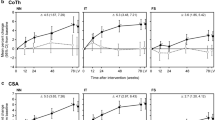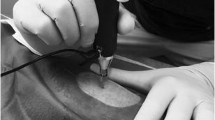Abstract
Introduction
Raloxifene improves spine bone mineral density (BMD), and its ability to reduce vertebral fractures by 40–50% suggests that it increases vertebral strength. Positive effects on hip BMD suggest a similar strengthening of the hip, but dimensional ambiguities in BMD by dual energy x-ray absorptiometry (DXA) make it difficult to infer strength effects directly. Hip fractures may be too infrequent to evaluate in practical clinical trials; even the Multiple Outcomes of Raloxifene Evaluation (MORE) study with 7,705 subjects was insufficiently powered to show a comparable reduction in hip fractures.
Methods
An alternative evaluation of hip DXA data in structural terms should provide more direct evidence of treatment effects on hip strength. Hip scans from a subset of the MORE study, including 4,806 postmenopausal women with osteoporosis randomized to daily oral doses of placebo, 60 mg, or 120 mg of raloxifene were reanalyzed by the hip structure analysis (HSA) method. Scans acquired at baseline, 1, 2, and 3 years were evaluated to extract BMD and cross-sectional geometry across the narrowest point on the neck (NN), the intertrochanteric region (IT), and the proximal shaft 1.5 times the minimum neck width distal to the intersection of the neck and shaft axes.
Results
While femur outer diameter expanded during follow-up at all three regions, there were no differences in expansion between groups; treatment influenced mainly the amount and distribution of bone within cross-sections. Effects were similar at the two dose levels at the NN region although the 120 mg dose produced a greater effect on section modulus (SM) at the IT region and on BMD, bone cross-sectional area (CSA), SM, average cortical thickness (CT), and buckling ratio (BR) at the shaft region. Compared with placebo after 3 years, treatment groups showed 0.4–2% higher BMD, CSA, SM, and CT and 1–2% lower BR. The smallest treatment effects were evident at the shaft at 60 mg.
Conclusions
We conclude that raloxifene does not influence periosteal apposition in the proximal femur but it nevertheless produces small but significant improvement in resistance to axial and bending stresses (CSA and SM, respectively) at all analyzed regions. The significant reductions in buckling ratio suggest that additional strength loss due to cortical instability is also ameliorated by treatment.








Similar content being viewed by others
References
Ettinger B, Black DM, Mitlak BH, Knickerbocker RK, Nickelsen T, Genant HK, Christiansen C, Delmas PD, Zanchetta JR, Stakkestad J, Gluer CC, Krueger K, Cohen FJ, Eckert S, Ensrud KE, Avioli LV, Lips P, Cummings SR (1999) Reduction of vertebral fracture risk in postmenopausal women with osteoporosis treated with raloxifene: results from a 3-year randomized clinical trial. Multiple Outcomes of Raloxifene Evaluation (MORE) Investigators. JAMA 282:637–645
Delmas P, Genant H, Crans G, Stock J, Wong M, Siris E, Adachi J (2003) Severity of prevalent vertebral fractures and the risk of subsequent vertebral and nonvertebral fractures: results from the MORE trial. Bone 33:522–532
Delmas P, Seeman E. Changes in bone mineral density explain little of the reduction in vertebral or nonvertebral fracture risk with anti-resorptive therapy. Bone 599–604
Martin RB, Burr DB (1984) Non-invasive measurement of long bone cross-sectional moment of inertia by photon absorptiometry. J Biomech 17:195–201
Beck TJ, Looker AC, Ruff CB, Sievanen H, Wahner HW (2000) Structural trends in the aging femoral neck and proximal shaft: analysis of the Third National Health and Nutrition Examination Survey dual-energy X-ray absorptiometry data. J Bone Miner Res 15:2297–2304
Beck TJ, Stone KL, Oreskovic TL, Hochberg MC, Nevitt MC, Genant HK, Cummings SR (2001) Effects of current and discontinued estrogen replacement therapy on hip structural geometry: the study of osteoporotic fractures. J Bone Miner Res 16:2103–2110
Khoo B, Beck T, Qiao Q, Parakh Q, Semanick L, Prince R, Singer K, Price R (2005) In vivo short-term reproducibility of hip structure analysis variables in comparison with bone mineral density using paired dual-energy x-ray absorptiometry scans from multi-centre clinical trials. Bone 37:112–121
Burr DB (1997) Muscle strength, bone mass, and age-related bone loss. J Bone Miner Res 12:1547–1551
Hayes WC, Myers ER (1994) Biomechanics of age-related fracture risk. New York: Raven press (Riggs BL, Milton LJ, eds. Osteoporosis: Etiology, Diagnosis and Management)
Feik SA, Thomas CD, Bruns R, Clement JG (2000) Regional variations in cortical modeling in the femoral mid-shaft: sex and age differences. Am J Phys Anthropol 112:191–205
Ruff C, Hayes W (1982) Subperiosteal expansion and cortical remodeling of the human femur and tibia with aging. Science 217:945–948
Smith R, Walker R (1964) Femoral expansion in aging women: Implications for osteoporosis and fractures. Science 145:156–157
van der Meulen MC, Beaupre GS, Carter DR (1993) Mechanobiologic influences in long bone cross-sectional growth. Bone 14:635–642
Heaney RP, Barger-Lux MJ, Davies KM, Ryan RA, Johnson ML, Gong G (1997) Bone dimensional change with age: interactions of genetic, hormonal, and body size variables. Osteoporos Int 7:426–431
Beck TJ, Oreskovic TL, Stone KL, Ruff CB, Ensrud K, Nevitt MC, Genant HK, Cummings SR (2001) Structural adaptation to changing skeletal load in the progression toward hip fragility: the study of osteoporotic fractures. J Bone Miner Res 16:1108–1119
Kaptoge S, Dalzell N, Jakes RW, Wareham N, Day NE, Khaw KT, Beck TJ, Loveridge N, Reeve J (2003) Hip section modulus, a measure of bending resistance, is more strongly related to reported physical activity than BMD. Osteoporos Int 14:941–949
Mayhew P, Thomas C, Clement J, Loveridge N, Beck T, Bonfield W, Burgoyne C, Reeve J (2005) Relation between age, femoral neck cortical stability, and hip fracture risk. Lancet 366:129–135
Young W (1989) Elastic stability formulas for stress and strain. In: Crawford H TS, ed. Roark’s Formulas for Stress and Strain, 6 edn. McGraw-Hill, New York, pp 688
Hillier TA, Beck TJ, Oreskovic T, Rizzo JH, Pedula KL, Black D, Stone KL, Cauley JA, Bauer DC, Taylor BC, Cummings SR (2003) Predicting long-term hip fracture risk with bone mineral density and hip structure in postmenopausal women: the study of osteoporotic fractures (SOF). In: Twenty-fifth annual meeting of the American society for bone and mineral research. Minneapolis, Minnesota, USA: American society for bone and mineral research
Duan Y, Beck TJ, Wang XF, Seeman E (2003) Structural and biomechanical basis of sexual dimorphism in femoral neck fragility has its origins in growth and aging. J Bone Miner Res 18:1766–1774
Filardi S, Zebaze R, Duan Y, Edmonds J, Beck T, Seeman E (2004) Femoral neck fragility in women has its structural and biomechanical basis established by periosteal modeling during growth and endocortical remodeling during aging. Osteoporos Int 15:103–107
Boivin G, Meunier P (2003) Methodological considerations in measurement of bone mineral content. Osteoporos Int 14 (Suppl 5):S22–S28
Boivin G, Lips P, Ott S, Harper K, Sarkar S, Pinnette K, Meunier P (2003) Contribution of raloxifene and calcium and vitamin D3 supplementation to the increase of the degree of mineralization of bone in postmenopausal women. J Clin Endocrinol Metab 88:4199–4205
Turner CH (2002) Biomechanics of bone: determinants of skeletal fragility and bone quality. Osteoporos Int 13:97–104
Chapuy M, Pamphile R, Paris E, Kemf C, Schlichting M, Arnaud S, Garnero P, Meunier P (2002) Combined calcium and vitamin D3 supplementation in elderly women: confirmation of reversal of secondary hyperparathyroidism and hip fracture risk: the Decalyos II study. Osteoporos Int 13:257–264
Schafer BW (2002) Local, distortional, and euler buckling in thin-walled columns. Journal of Structural Engineering 128:289–299
Uusi-Rasi K, Semanick L, Zanchetta J, Bogado C, Eriksen E, Sato M, Beck T (2005) Effects of Teriparatide [rhPTH (1–34)] Treatment on structural geometry of the proximal femur in elderly osteoporotic women. Bone 36:948–958
Acknowledgements
HSA analysis of DXA data was supported by a contract from Eli Lilly and Company, Indianapolis, Indiana, USA, with The Johns Hopkins University School of Medicine.
Author information
Authors and Affiliations
Corresponding author
Additional information
This study was supported by a grant from Eli Lilly and Company.
Rights and permissions
About this article
Cite this article
Uusi-Rasi, K., Beck, T.J., Semanick, L.M. et al. Structural effects of raloxifene on the proximal femur: results from the multiple outcomes of raloxifene evaluation trial. Osteoporos Int 17, 575–586 (2006). https://doi.org/10.1007/s00198-005-0028-3
Received:
Accepted:
Published:
Issue Date:
DOI: https://doi.org/10.1007/s00198-005-0028-3




